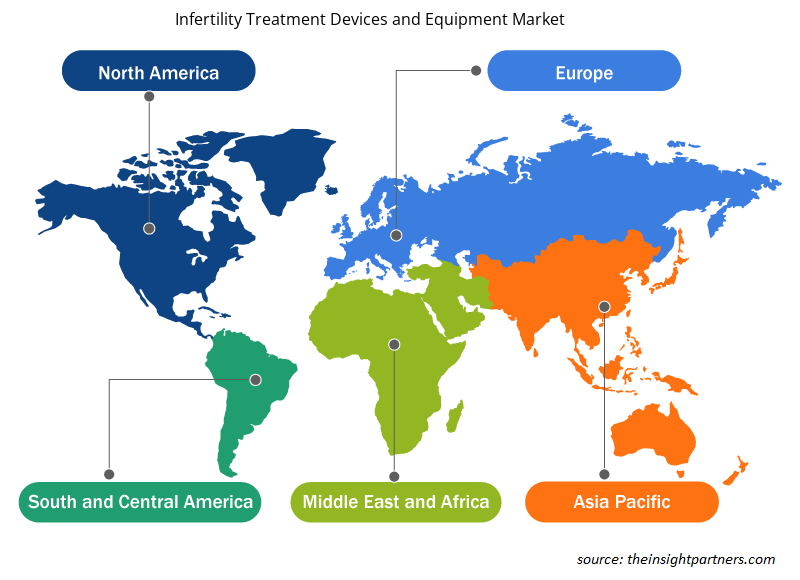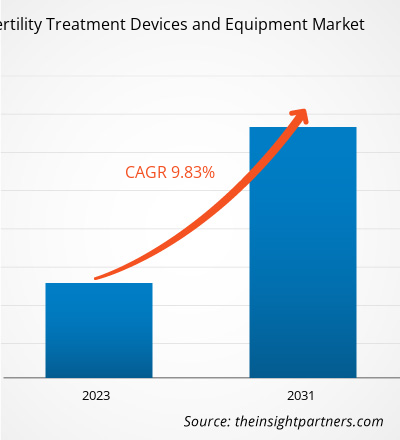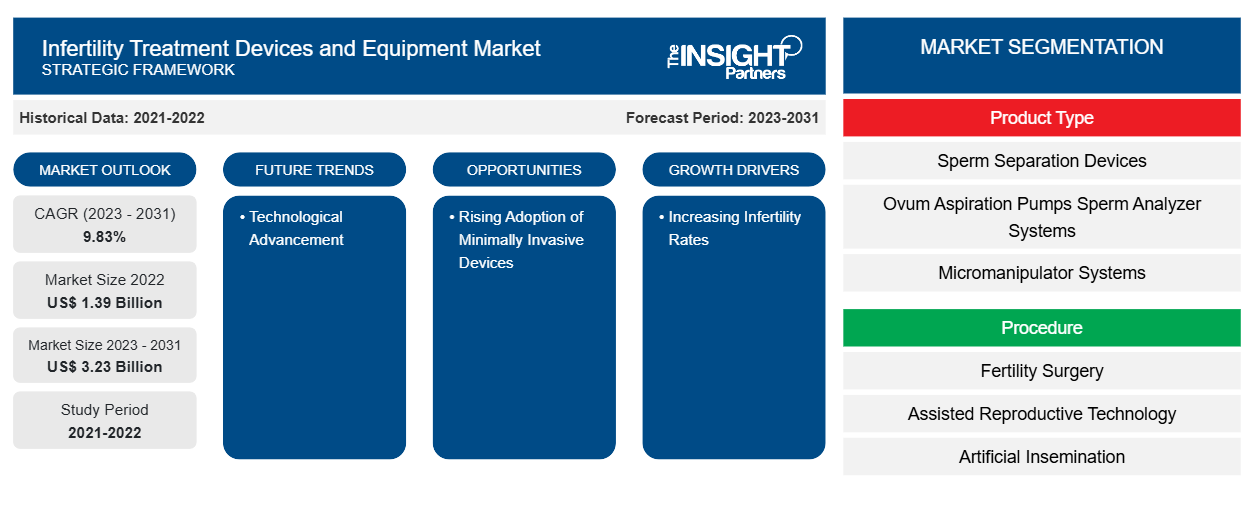不孕不育治疗设备和器械市场规模预计将从 2022 年的 13.9 亿美元增至 2031 年的 32.3 亿美元。预计 2023-2031 年市场复合年增长率将达到 9.83%。卵胞浆内精子注射等新型不孕不育治疗方法的开发可能仍将是不孕不育治疗设备和器械市场的主要趋势。
不孕不育治疗设备及器械市场分析
不孕症是指在一年无保护性行为后仍无法怀孕。世界卫生组织 (WHO) 已将其视为公共卫生问题。全球不孕症治疗设备和器械市场正在经历显著增长,原因包括全球生育率下降、先进生殖技术成功率提高以及政府和其他医疗机构的支持日益增加。这些因素有望促进提高生育能力的新疗法的开发。
不孕不育治疗设备及器械市场概况
据世界卫生组织报道,全球近17.5%的成年人患有不孕症。高收入国家的不孕症终生患病率为17.8%,低收入和中等收入国家的不孕症终生患病率为16.5%。不孕症病例的增加导致寻求不孕症治疗的患者数量增加。这凸显了对负担得起的高质量生育护理的需求,这有助于不孕症治疗设备和设备市场的扩张。
定制此报告以满足您的需求
您可以免费定制任何报告,包括本报告的部分内容、国家级分析、Excel 数据包,以及为初创企业和大学提供优惠和折扣
- 获取此报告的关键市场趋势。这个免费样品将包括数据分析,从市场趋势到估计和预测。
不孕不育治疗设备及器械市场驱动因素及机遇
先进不孕不育治疗技术成功率高 市场青睐
生殖治疗取得了显著进展,扩大了辅助生殖技术 (ART) 等不孕不育治疗的选择和成功率。根据 2022 年 10 月在 Cureus 上发表的一篇文章,在未来几年,IVF 预计将在全球多个地区得到广泛应用,导致多达 10% 的儿童出生,体外成熟 (IVM) 的成功率由于技术进步、必要工具的改进以及执行该程序的人员的经验和培训的积累而提高到 56%。此外,生育意识方法(如排卵跟踪应用程序)变得更加容易获得和可靠,从而可以做出明智的计划生育决策
微创设备——不孕不育治疗的机遇
子宫肌瘤、苗勒氏管畸形、卵巢囊肿和子宫内膜异位症等多种异常和病症都会降低怀孕几率。这些问题还会引起不良副作用,包括慢性盆腔疼痛和大量出血。在这种情况下,手术干预可能是治疗这些症状最有效的方法。采用腹腔镜和宫腔镜等微创技术可以解决不孕症的根本原因,减少疼痛、恢复时间、感染风险和失血。这些手术涉及使用小切口和高清摄像头,将手术区域投射到显示器上,而不是传统手术中使用的大切口。
不孕不育治疗设备和器械市场报告细分分析
促成不孕症治疗设备和设备市场分析的关键部分是产品类型、程序和最终用户。
- 根据产品类型,不孕不育治疗设备和设备市场分为精子分离设备、卵子抽吸泵、精子分析系统、微操作系统、孵化器等。卵子抽吸泵部分在 2023 年占据了最大的市场份额。
- 根据程序,市场分为辅助生殖技术、生育手术和人工授精。人工授精部分在 2023 年占据了最大的市场份额。此外,辅助生殖技术部分预计将在 2023 年至 2031 年期间实现最高的复合年增长率。
- 就最终用户而言,市场分为生育诊所、医院和其他医疗机构以及临床研究机构。生育诊所部门在 2023 年占据了市场主导地位。
不孕不育治疗设备及器械市场份额(按地区)分析
不孕不育治疗设备和设备市场报告的地理范围主要分为五个区域:北美、亚太、欧洲、中东和非洲、南美和中美。
北美在不孕不育治疗设备和设备市场占据主导地位。根据美国卫生与公众服务部的数据,2021 年,美国出生的婴儿中约有 2.3% 是使用 ART 受孕的,在 453 家诊所进行了约 413,776 个周期,导致 112,088 例怀孕。IVF 等 AR 程序数量的增加、男性不孕不育率的上升以及全球市场参与者的存在是导致北美不孕不育治疗设备和设备市场占据主导地位的因素。预计亚太地区将在未来几年以最高的复合年增长率增长。
不孕不育治疗设备和设备市场区域洞察
Insight Partners 的分析师已详细解释了预测期内影响不孕症治疗设备和设备市场的区域趋势和因素。本节还讨论了北美、欧洲、亚太地区、中东和非洲以及南美和中美洲的不孕症治疗设备和设备市场细分和地理位置。

- 获取不孕不育治疗设备和设备市场的区域特定数据
不孕不育治疗设备和器械市场报告范围
| 报告属性 | 细节 |
|---|---|
| 2022 年市场规模 | 13.9亿美元 |
| 2031 年市场规模 | 32.3亿美元 |
| 全球复合年增长率(2023 - 2031) | 9.83% |
| 史料 | 2021-2022 |
| 预测期 | 2023-2031 |
| 涵盖的领域 | 按产品类型
|
| 覆盖地区和国家 | 北美
|
| 市场领导者和主要公司简介 |
|
不孕不育治疗设备和设备市场参与者密度:了解其对业务动态的影响
不孕不育治疗设备和器械市场正在快速增长,这得益于终端用户需求的不断增长,而这些需求又源于消费者偏好的不断变化、技术进步以及对产品优势的认识不断提高等因素。随着需求的增加,企业正在扩大其产品范围,进行创新以满足消费者的需求,并利用新兴趋势,从而进一步推动市场增长。
市场参与者密度是指在特定市场或行业内运营的企业或公司的分布情况。它表明在给定市场空间中,相对于其规模或总市场价值,有多少竞争对手(市场参与者)存在。
在不孕不育治疗设备和设备市场运营的主要公司有:
- 赛默飞世尔科技
- 库克集团
- 维特罗莱夫
- IVFtech APS
- 汉密尔顿索恩有限公司
- Esco Micro 私人有限公司
免责声明:上面列出的公司没有按照任何特定顺序排列。

- 了解不孕不育治疗设备和设备市场的主要参与者概况
不孕不育治疗设备及器械市场新闻及最新发展
不孕不育治疗设备和器械市场通过收集一级和二级研究后的定性和定量数据进行评估,其中包括重要的公司出版物、协会数据和数据库。以下是不孕不育治疗设备和器械市场的发展列表:
- Trajan Scientific and Medical 向德国初创公司 Fertilly 供应 CE-IVD 注册的 Mitra 设备。Fertilly 推出了欧洲首款使用 VAMS 技术进行干血微量采样的家用生育测试套件。Mitra 微量采样设备可通过指尖采血快速轻松地采集血液样本,然后将其邮寄到实验室进行干血分析。(来源:Trajan Scientific Australia Pty Ltd,新闻稿,2023 年)
- 默克印度医疗保健业务部门 Merck Specialties Pvt ltd 在印度推出了用于治疗晚期不孕症的 Pergoveris Pen。此次发布强调了该公司通过为患有严重促卵泡激素 (FSH) 和促黄体激素 (LH) 缺乏症的女性提供改进、方便且随时可用的组合治疗选择来满足未满足的医疗需求的动机。(来源:Merck Specialties Pvt ltd,新闻稿,2021 年)
不孕不育治疗设备和设备市场报告范围和交付成果
“不孕不育治疗设备和设备市场规模和预测(2021-2031)”报告对以下领域进行了详细的市场分析:
- 范围内所有主要细分市场的全球、区域和国家层面的市场规模和预测
- 市场动态,如驱动因素、限制因素和关键机遇
- 未来主要趋势
- 详细的 PEST/波特五力分析和 SWOT 分析
- 全球和区域市场分析涵盖关键市场趋势、主要参与者、法规和最新市场发展
- 行业格局和竞争分析,涵盖市场集中度、热点图分析、知名参与者和最新发展
- 详细的公司简介
- 历史分析(2 年)、基准年、预测(7 年)及复合年增长率
- PEST和SWOT分析
- 市场规模、价值/数量 - 全球、区域、国家
- 行业和竞争格局
- Excel 数据集
近期报告
客户评价
购买理由
- 明智的决策
- 了解市场动态
- 竞争分析
- 客户洞察
- 市场预测
- 风险规避
- 战略规划
- 投资论证
- 识别新兴市场
- 优化营销策略
- 提升运营效率
- 顺应监管趋势





















 获取免费样品 - 不孕不育治疗设备和器械市场
获取免费样品 - 不孕不育治疗设备和器械市场